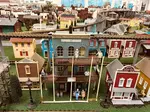 |
Troubleshooting Model Train Derailments

Train derailments are one of the most frustrating problems that model railroaders have to deal with. Usually the problem can be avoided by meticulous attention to detail when laying your track in the beginning. Sometimes even despite that there will still be problems that require troubleshooting. Over the years rails and subroadbed may expand and contract a number of times in response to changes in temperature and humidity which can throw your well-aligned joints out of whack.
The following is a list of things to consider when train derailments are giving you a headache:
~ Make sure the rails are clean and there are no obstructing pieces of glue or plaster attached to the top or inside of either rail.
~ Make sure your scenery is glued and fastened to the layout surface as much as possible. Loose ballast and bits of foliage lying on the track has been one of the greatest causes of derailments on my layout and, I would guess, many others.
~ Are the rail joints lined up properly? Are both rails well-seated in the rail joiner? If the rails are not lined up well, you can usually feel the edge or end of one of the rails as you run your finger over the joint. If this is the case, sometimes you can even them up by filing one of the rail ends so that the joint lines up better on the top and on the inside where the wheel meets the rail. If one of the rail ends is bent sideways, use a pair of needle-nosed pliers to try to bend it back in position. Once the rails are in good position, check the gauge with a standard gauge measurement instrument you can buy from the NMRA. If it's in good position, try running a 4 wheeled truck or a rail car over the area backwards and forwards to see if there is still a problem. If everything seems to be okay, it might be helpful to solder the joint to keep it in place.
~ Could the problem be a faulty wheelbase of one of your rail cars? Try using different cars over the area in question and see if other cars have the same problem. If not, try replacing the wheel base of the first car with a new set of wheels.
~ Could the weight of the rail car be too light causing the wheels to jump rail too easily? There are standards set by the NMRA as to what the ideal weight should be for various engines and cars. You can add weights that are made for this purpose. They should be distributed evenly and fastened to the inside of the car with some double-sided mounting tape.
~ Make sure the rail gauge is correct. If not, try to either widen or narrow the rail with pliers or, if that doesn't work, try replacing the track in that area.
~ Check the trucks on your rolling stock. If there is too much play, or lateral movement, of your wheels, replace the trucks.
~ If your train derailment is occurring over a turnout, check the gauge of various places in the turnout where the wheels travel, and make adjustments if necessary. Check and see if the points of the turnout are seated well against the side of the rail and that the wheels are not getting stopped or thrown off by the points being out of position. File the points of the turnout if necessary to be sure they lie smooth or flush with the rail. Use a plain truck without the car attached and run it back and forth over the turnout to see where the disruption is occurring. If you can find the problem, try to file down whatever is causing the wheel to jump the track. If you still can't stop the train derailments, replace the turnout.
~ If you've done all the above and you're still having problems, you could try using a guard rail on the inside of one or both rails to hold your wheels in line as they are traveling along the rail. (This wouldn't be applicable for turnouts though.)
~ Make sure the couplers on your cars or engines are in proper position and sitting at the right height above the track. Once again, there are standards for this. One of the NMRA gauge devices appropriate for your scale can be used to check this.
When everything is running properly, you should be able to run your trains forward and backward over your entire layout multiple times without a derailment.
*This page was last updated on August 30, 2020.*
From "Train Derailments" to "Model Railroad Track"
Contact Me | Blog | Photos | References | Supplies | GiftShop | Sitemap | Search | Comment | Privacy Statement | Disclosures
Tracks Newsletter: Sign Up Here!
√ = ad or sponsored link
What's New on BYMRR.com?
Recent Articles
-
Model Railroad Supplies
Dec 16, 25 03:46 PM
We have started a new store to help you build your layout and teach your youngsters about science with STEM products. -
DC and/or DCC on the Same Layout
Mar 09, 25 10:46 AM
How to wire your layout for either DC and/or DCC operation. -
Looking for a locomotive speaker
Nov 24, 24 07:29 AM
First Name: Randy E-Mail Address: bymrr@building-your-model-railroad.com Enter your question: : I am looking for a speaker for a Walthers EMD SD70ACE Locomotive, product number 910-9866. The control b…







